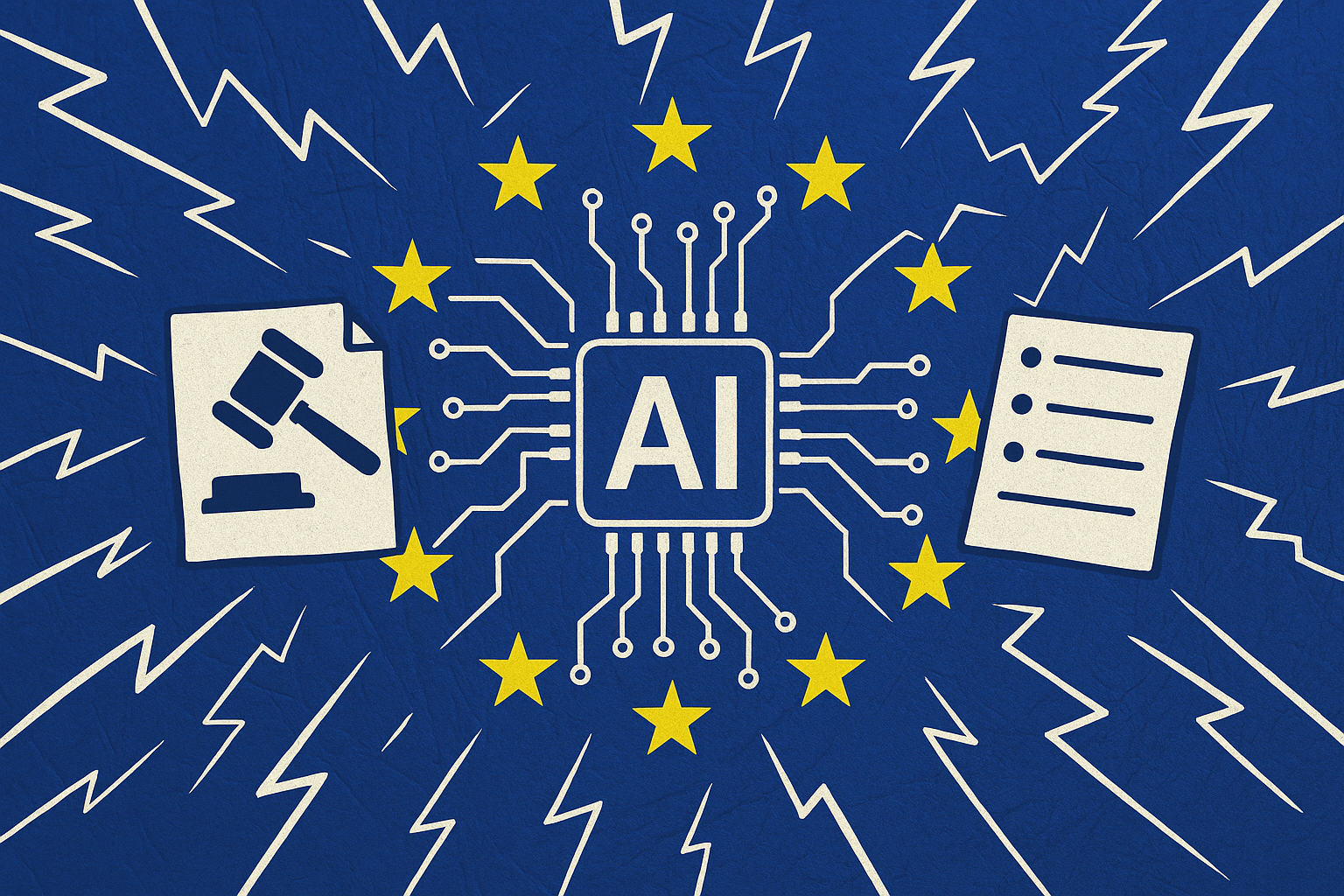Imagine a small London start-up that has built an AI résumé-screener. Overnight, its legal to-do list jumped from “find office plants” to “appoint an EU representative, perform a conformity assessment, and document every training image ever used.” The trigger was not a British law, but a 144-page regulation printed 1,000 kilometres away in Brussels. Welcome to the post-AI-Act era, where geography is optional but compliance is not.
The Act, which quietly entered the EU’s Official Journal last July, is the first time a major government has turned AI ethics from TED-talk fodder into hard law. It sorts every line of code on earth into four risk buckets–unacceptable, high, limited and minimal–then attaches fines the size of small national budgets. From 2 February 2025, real-time facial recognition in public squares and AI systems that nudge children into harmful behaviour become outright illegal. Anything that vets job applicants, runs a power grid or decides who gets a loan must survive a gauntlet of risk-management files, human oversight and third-party audits before it can be switched on in Europe.
That last clause is the kicker. “Europe” here is a legal fiction that reaches far beyond its borders. If a São Paulo coder sells an AI tool to a café in Lisbon, the Act applies. If a New York hedge fund’s algorithmic trades are routed through Frankfurt, the Act applies. The Brussels Effect–once the polite term for Europe’s habit of writing the world’s product-safety rules–has morphed into an extra-territorial octopus.
Europe’s own gamble
Europe’s internal debate sounds like a family argument at Christmas dinner. Margrethe Vestager, the Commission’s tech-sheriff, argues that trust is the continent’s only realistic competitive edge: “If citizens fear AI, they won’t use European AI.” Critics counter with spreadsheets showing up to €400,000 in compliance costs for a single high-risk system–enough to erase 40 % of an SME’s profit. Meanwhile, national regulators from Tallinn to Athens admit they can’t yet hire the AI engineers they would need to read those spreadsheets, let alone challenge them.
The result is a paradox baked into the Act itself: the EU is simultaneously subsidising AI start-ups through its €150 billion “Digital Decade” package while charging them six-figure admission tickets to the market it wants them to conquer.
Britain’s awkward two-step
Post-Brexit Britain had hoped to dance to its own tune. The UK’s March 2023 White Paper promised “agile” principles enforced by existing watchdogs rather than a single AI czar. But the music changed. Any British firm that wants customers inside the EU single market must still obey Brussels’ choreography. Inside the UK, this has quietly created a two-tier economy: companies serving only domestic users enjoy the freedom of a gentleman’s agreement, while those eyeing Paris or Berlin are lawyering up as if they were headquartered in Belgium. The government’s forthcoming “AI Opportunities Action Plan” may harden some rules, yet it cannot soften the gravitational pull of 450 million EU consumers across the Channel.
America’s fork in the road
Across the Atlantic, the Act has landed like a philosophical gauntlet. Washington’s default setting is still “innovation first, lawsuits later.” The Biden administration encouraged voluntary safety pledges; the Trump team’s latest executive order explicitly tells agencies to delete any reference to “misinformation” or “equity” from AI guidance. Yet American giants are already building “Brussels-ready” versions of their models. Microsoft now markets compliance-as-a-service; Google’s internal style guide reportedly asks engineers to imagine an EU auditor reading every commit message.
The question is whether these companies will eventually ship a single, EU-grade product worldwide–spreading Europe’s precautionary model by default–or whether Washington will push back with a deliberately looser counter-standard, forcing firms to run parallel codebases in what one Silicon Valley GC calls “regulatory cold war mode.” Early signs point to the latter: the DOJ antitrust division has hinted that over-complying with foreign rules could itself raise competition concerns.
The industry fracture
Look closer at Big Tech and you see the Act acting like an X-ray on business models.
• Microsoft, whose revenue increasingly depends on selling trustworthy cloud services to risk-averse banks and hospitals, has embraced the Act as a moat against nimbler rivals.
• Meta, whose empire rests on open-source models and oceans of user data, has refused to sign the EU’s voluntary Code of Practice, arguing that transparency clauses could expose trade secrets.
• Amazon Web Services occupies the pragmatic middle, promising clients the audit logs and security certifications they need, while lobbying behind the scenes against what it calls “prescriptive innovation taxes.”
The open-source squeeze
Perhaps nowhere is the squeeze more Kafkaesque than in open source. The Act exempts “AI systems released under free and open-source licences”–but only if they stay tiny, un-monetised and free of any “high-risk” purpose. The moment your open-source résumé-scanner becomes popular, crosses the 10²⁵ FLOPs training threshold, or accepts GitHub sponsorship, the exemption evaporates. Overnight, a volunteer maintainer in Helsinki could owe the same documentation stack as Google. Critics warn this could quietly kill the very community that produced Linux, PyTorch and the transformer architecture now fuelling the boom.
The China question
Then there is the supply-chain headache. An EU retailer that plugs a Chinese facial-recognition API into its shop cameras must, under the Act, ensure the API complies with European fundamental-rights law–something the retailer cannot realistically verify, since Chinese providers are bound by Beijing’s national-security statutes. Add the GDPR’s restrictions on data transfers, and many lawyers are quietly advising clients to treat Chinese models like radioactive waste: technically usable, legally explosive. The likely outcome is a slow-motion decoupling, with European developers paying premiums for “regulatory-safe” components from allied jurisdictions.
Four rival operating systems
Zoom out and the planet is crystallising into four competing AI operating systems:
1. EU: Rights-first, pre-market, heavy paperwork.
2. US: Market-first, post-hoc enforcement, state-by-state patchwork.
3. UK: Innovation-pragmatic, still writing the footnotes.
4. China: State-first, security-screened, vertically governed.
None is clearly “winning.” Each is optimising for a different societal goal–dignity, dominance, agility, or control–and each is exporting its template through trade gravity rather than diplomatic consensus.
What to do on Monday morning
For policymakers outside Brussels, denial is no longer an option. The pragmatic play is to recognise the Act as the new global floor and to build interoperability on top of it–harmonising technical standards even when legal philosophies diverge. That means funding regulators who can speak Python as well as legalese, and racing to lead international bodies like the G7’s Hiroshima Process before the EU does.
For corporate leaders, the smartest insurance policy is to stop treating the Act as a regional footnote. Set up an internal AI governance board, map every system against the EU’s risk ladder, and budget for transparency tools that let you explain–at the level of individual training tokens–why your model made the decision it did. In a fragmented world, the companies that can prove trustworthiness fastest will sign the biggest contracts, even in jurisdictions still figuring out what “trust” means.
And for the rest of us? We are living through the moment when code began to carry passports. The AI Act is not the end of that story; it is merely chapter one. The next chapters will be written in courtrooms in Luxembourg, server farms in Oregon, and–if the open-source community survives–pull requests from developers who still believe software should be borderless. The only certainty is that every line of code we deploy today will have to choose which regulatory universe it wants to live in tomorrow.
Disclaimer: Important Legal and Regulatory Information
This report is for informational purposes only and should not be construed as financial, investment, legal, tax, or professional advice. The views expressed are purely analytical in nature and do not constitute financial guidance, investment recommendations, or a solicitation to buy, sell, or hold any financial instrument, including but not limited to commodities, securities, derivatives, or cryptocurrencies. No part of this publication should be relied upon for financial or investment decisions, and readers should consult a qualified financial advisor or regulated professional before making any decisions. Bretalon LTD is not authorized or regulated by the UK Financial Conduct Authority (FCA) or any other regulatory body and does not conduct activities requiring authorization under the Financial Services and Markets Act 2000 (FSMA), the FCA Handbook, or any equivalent legislation. We do not provide financial intermediation, investment services or portfolio management services. Any references to market conditions, asset performance, or financial trends are purely informational and nothing in this report should be interpreted as an offer, inducement, invitation, or recommendation to engage in any investment activity or transaction. Bretalon LTD and its affiliates accept no liability for any direct, indirect, incidental, consequential, or punitive damages arising from the use of, reliance on, or inability to use this report. No fiduciary duty, client-advisor relationship, or obligation is formed by accessing this publication, and the information herein is subject to change at any time without notice. External links and references included are for informational purposes only, and Bretalon LTD is not responsible for the content, accuracy, or availability of third-party sources. This report is the intellectual property of Bretalon LTD, and unauthorized reproduction, distribution, modification, resale, or commercial use is strictly prohibited. Limited personal, non-commercial use is permitted, but any unauthorized modifications or attributions are expressly forbidden. By accessing this report, you acknowledge and agree to these terms-if you do not accept them, you should disregard this publication in its entirety.



